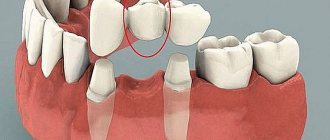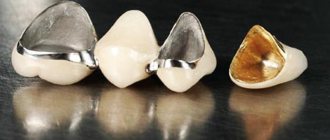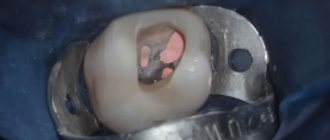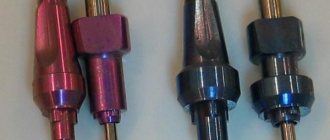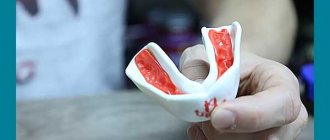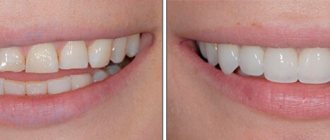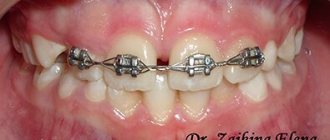169
The advantages of physiotherapy - effectiveness, versatility, duration of action, compatibility with other types of treatment, accessibility - are fully manifested in dentistry.
Physiotherapeutic methods are successfully used in the prevention and treatment of many dental diseases.
The choice of one type of physiotherapy or another depends on the characteristics and severity of the pathology, the condition and age of the patient, and his tolerance to a specific physical factor.
General concept
Fluctuarization (Latin Fluctuor - fluctuate) is one of the types of physiotherapy that uses low-voltage direct and alternating current with arbitrarily varying amplitude and frequency in the range of 100-2000 Hz as an influencing factor.
The randomness and unpredictability of changes in these parameters prevents the tissues of the human body from getting used to them. There is no adaptation to the physical factor and no reduction in the effectiveness of treatment due to this.
This makes fluctuarization more effective compared to other electric currents used in treatment - dynamic, modulated and sinusoidal.
The most powerful effect of fluctuarization is pain relief. But along with it, there is a pronounced anti-inflammatory, decongestant and other therapeutic effect.
To carry out the procedure, devices ASB-2-1 (desktop) and FS-100-4 (portable) are used, creating a current density from 0 to more than 2 mA/cm2.
The treatment procedure involves applying electrodes to certain areas of the maxillofacial region and oral cavity, depending on the disease.
The session is carried out in the form of daily or extra-daily sessions lasting 18-15 minutes, with a total of 10-12 procedures.
The use of hyaluronic acid in dentistry and its unique properties.
Come here if you are interested in how popular vacuum therapy is in dentistry.
At this address https://www.vash-dentist.ru/lechenie/desnyi/fotosan-v-stomatologii.html find out when the Fotosan system is used in dentistry and how it works.
Negative consequences
Reviews from doctors and patients indicate that fluctuarization rarely causes side effects. The method is well tolerated and can be used for a wide range of diseases of internal organs.
However, if the procedure is prescribed incorrectly, namely, non-compliance with indications and contraindications, patients may experience irritation and damage to the skin, progression of concomitant pathologies (malignant neoplasms, acute infectious processes, etc.). To prevent such conditions, patients should be thoroughly examined before undergoing physical treatment, and also report information about existing diseases to their doctor.
Physiotherapeutic techniques, including fluctuarization, are widely used in the treatment of diseases of internal organs and dentistry. Such methods make it possible to increase the effectiveness of complex therapy and reduce the risk of side effects. Fluctuarization can be performed at home after preliminary training from specialists, or in a medical institution under the supervision of medical professionals. The appointment and selection of a specific type of physiotherapy, as well as the parameters of the effect on the body, is always carried out by the attending physician. Any attempts at self-medication are fraught with the development of negative consequences and the progression of concomitant pathologies.
Operating principle
Passing through the blood and lymph of human tissue, an electric current of a certain strength causes muscle fibrillation, expressed in their chaotic twitching.
In this case, the temperature of the oral mucosa rises by approximately 0.4°C, and metabolic processes are activated in the lesions, leading to a number of pronounced therapeutic effects:
- Pain relief . It is caused by the “quenching” of pain impulses due to a decrease in the excitability of the nerves when an electric current passes through them.
- Reduction or complete elimination of inflammation .
Under the influence of an electrical signal, lymph and blood flow are activated, leading to stimulation of enzyme activity and phagocytosis. Inflammation is reversed, swelling decreases due to resorption of the infiltrate, purulent foci are delimited from the “healthy” tissue and begin to shrink. Fistula tracts that drain pus may form. The end result is resolution of inflammation. - Regeneration (reparation) of affected tissues. Increased circulation of lymph and blood accelerates metabolic and regenerative processes, leading to rapid healing of the wound.
- Local myostimulation , increasing the functional state of muscles.
- Increasing trophism . There is an improvement in tissue nutrition, leading to their accelerated recovery.
As the current intensity increases (within certain limits) and the number of sessions increases, the therapeutic effect usually increases.
Contraindications and effects
It is important to remember that there are certain contraindications for the use of physiotherapy methods using pulsed currents:
- Tumors of various etiologies;
- Individual intolerance to exposure;
- Pregnancy (second trimester);
- Hemarthrosis in the acute stage;
- Kidney and cholelithiasis;
- Spastic state of muscles;
- Dislocations, bone fractures;
- Bleeding.
Current pulses have an exciting, stimulating and irritating effect on the human body. Passing through the tissues of the body, the current causes increased functions of cell membranes and tissue tension. Cells are activated, their vital activity improves, the functioning of joints, blood vessels and nerve fibers is restored. This helps speed up the treatment of many diseases, as well as avoid all sorts of complications.
In general, as a result of exposure to pulsed currents, the following occurs:
- Reducing congestion in the pelvis;
- Metabolism improves, the body's defenses increase;
- The synthesis of organ secretion is activated;
- The permeability of cell membranes increases.
Physiotherapeutic procedures using pulsed current activate blood flow, so the drugs used penetrate the tissues faster, and the effectiveness of treatment increases.
Indications and restrictions
The list of indications is quite wide. A good therapeutic effect is observed in the treatment of the following pathologies of the oral cavity:
- Acute inflammatory diseases of the periodontium and oral mucosa (gingivitis, alveolitis, etc.).
- Exacerbations of chronic inflammation (temporomandibular joint arthritis, periodontitis, pulpitis, alveolitis).
- Purulent processes in the oral cavity (phlegmon, abscesses);
- Neuralgic pathologies (inflammation of the trigeminal, occipital and peripheral nerves).
- Impaired tone and contracture of the masticatory muscles.
- Diseases of the salivary glands.
- Post-filling pain, etc.
Due to the great influence of physiotherapy on metabolism in the area of influence of the physical factor, its use requires great caution.
The procedure is contraindicated for patients with the following pathologies and abnormalities:
- Blood diseases, low coagulability, bleeding, leukemia.
- Cancer pathologies.
- AH in the 3rd stage.
- Severe general exhaustion.
- Stroke, cerebral atherosclerosis.
- Uncompensated cardiovascular diseases.
- Temperature above 38 °C.
- Active pulmonary tuberculosis.
- Epilepsy.
- The presence of a pacemaker and metal in the tissues.
- Thrombobliterating diseases.
- Vibration disease.
- Electric current intolerance.
- Severe mental conditions associated with fear, anxiety and restlessness.
- Meniere's syndrome (increased amount of endolymph in the ear).
- Acute infections.
- Post-infarction state (within a year after the heart attack).
Acute inflammation imposes a limitation on the number of daily sessions. They should not last more than 5 days. Subsequent procedures are carried out every other day.
It is not recommended to prescribe sessions to patients with increased body reactivity and reduced immunity.
Purpose of Perio Flow technology and its capabilities.
This publication provides a detailed description of the Florida Probe.
Here https://www.vash-dentist.ru/lechenie/desnyi/kak-mozhno-poluchit-ozhog.html all the most important things about how to treat a gum burn.
Selecting patients for physical therapy
All treatment methods are associated with the risk of side effects or ineffective use. In order to achieve maximum effect from the use of therapeutic procedures, doctors follow certain indications and contraindications when prescribing them. It is recommended to prescribe fluctuarization (flyuktuorizaciya) for the following conditions:
- degenerative changes in intervertebral discs with the development of osteochondrosis and radicular syndrome;
- arthritis and arthrosis of any cause;
- diseases of the peripheral nervous system;
- dental pathology: pulpitis, periodontitis, alveolitis and pain after tooth extraction;
- postoperative rehabilitation;
- diseases in gynecology.
In addition to the indications, doctors should also observe contraindications for fluctuarization for successful therapy:
- benign or malignant tumors;
- serious condition of patients due to pathology of internal organs;
- disruption of hemostasis;
- increased body temperature, including with an unknown cause;
- presence of a pacemaker or other metal devices;
- intolerance to electric current;
- impaired skin sensitivity.
If any of these contraindications are identified, fluctuarization should not be used. Otherwise, there is a high risk of progression of concomitant pathologies.
Technique
For the procedure, ASB-2-1 and FS-100-4 devices are used, providing the following current densities:
- Low (up to 1 mA/cm2). Allows you to obtain a pronounced analgesic effect. The patient feels a burning and tingling sensation at the electrode connection sites.
- Average (1-2 mA/cm2). It has an anti-inflammatory effect on lesions located close to the surface of the skin or mucous membrane. The patient feels it as vibration, causing a slight contraction of muscles close to the surface.
- High (more than 2 mA/cm2). An anti-inflammatory and absorbable effect appears in lesions located deep in the tissues.
The methods used depend on the tasks facing the dentist. This may affect pain points, salivary glands, masticatory muscles, trigeminal nerve, TMJ, etc.
Therapy for pain points
The patient assumes a position in which his head rests on the headrest. A bifurcated electrode Ø 25 mm is applied with one leg to a point located 5 mm anterior to the tragus of the ear, the other leg is moved along the branches of the nerve, applying it in places of pain.
The time for applying the maximum tolerated current to each point is 1 minute, the course of treatment is 6-8 procedures. The first 4-5 sessions are carried out daily, subsequent sessions every other day.
Treatment of parotid salivary glands
Separate electrodes with an area of 2-3 cm2 are used, placing them on the poles of the gland. An average current density is used, causing pronounced vibrations. The duration of one session is 10 minutes, the number of procedures is 6-12.
Normalization of masticatory muscle tone
One 4 cm2 electrode is applied to a point located on the zygomatic arch 5 mm in front of the tragus of the auricle, the second - in the area of the LF angle. Set the maximum tolerated current for 6 minutes.
Current supply mode: 1 minute - push-pull, continuous, then changing polarity, and “short period” for 2 minutes.
Trigeminal nerve therapy
An electrode with an area of 300 cm2 (“Bergonier Half Mask”) is placed on the affected part of the face. The second is on the cervical region of the spine. The current strength should cause a painless but pronounced vibration. Course – up to 15 sessions every other day.
High voltage currents
Darsonvalization
The most widely used method of exposure to pulsed alternating sinusoidal current of high frequency (110 and 440 kHz), high voltage (20 kV) and low current (0.02 mA). High-frequency pulse current (110 kHz) is used for local effects and is called local darsonvalization. It has an antispastic effect on the tone of peripheral vessels and smooth muscles, improves tissue trophism and reduces pain.
To carry out local darsonvalization, the Iskra-1 and Iskra-2 devices are used. 8 vacuum electrodes are attached to the device, among them rectal, large and small vaginal.
Local darsonvalization affects the area of the external genitalia and the perineum. They use a small mushroom-shaped electrode and a labile technique. First, the labia minora and majora are affected, then the perineum. The power of exposure is adjusted until the patient feels a slight warmth. Duration 6-10 minutes. Procedures are carried out daily. The course of treatment is 3-5 procedures.
During the vaginal procedure, a vaginal or large rectal electrode is inserted to a depth of 8-12 cm. The power of exposure is adjusted until the patient feels a slight warmth. Duration 10-15 minutes. Procedures are carried out daily or every other day. The course of treatment is 10-20 procedures.
During general darsonvalization, the patient is inside a large solenoid, through the turns of which a pulsed high-frequency (440 kHz) current passes. General darsonvalization helps slow down blood clotting, has a positive vasotropic effect, and enhances tissue metabolism. By reducing cerebral vascular tone, fatigue and headaches are reduced, sleep, mood, and performance are improved.
Rectal procedure. The rectal electrode is inserted into the rectum to a depth of 6 cm. The remaining parameters of the procedure are the same as for the vaginal procedure. The course of treatment is 10-20 procedures.
Features of treatment for children
The child’s body has both systemic and local anatomical and physiological characteristics.
The oral mucosa in children under 3 years of age has high vascularization and permeability, a thin epithelial cover, and a low level of cellular immunity.
Systemic differences lie in the characteristics of the cardiovascular, nervous and endocrine systems, metabolism and thermoregulation that are different from adults.
In this regard, the effects of the physical factors of physiotherapy in children occur at a lower dosage and faster than in adults. Not only those receptors that are located directly in the area of energy application are affected, but also those deep-lying ones.
On the one hand, this contributes to the effectiveness of physiotherapeutic treatment, on the other hand, it requires increased caution during its implementation.
A specialist conducting sessions with children must comply with the following rules:
- Begin treatment with a lower current intensity than in adults.
- Reduce the time of sessions and their number depending on the age of the child.
- Conduct sessions mostly every other day. In this case, treatment of acute inflammatory processes is carried out daily for the first 3-5 days, then every other day.
- Constantly monitor the child’s condition during treatment, paying attention to factors such as sleep, appetite, and body weight. If negative aspects appear, it is necessary to reduce the intensity of the procedures or abandon them.
In general, fluctuarization in children requires a strictly individual approach, taking into account the physical and psychological state of the child and a willingness to refuse therapy if the child shows signs of mental and physical fatigue.
The video provides additional information on the topic of the article.
Methodology for various diseases of the oral cavity
Fluctuarization devices are equipped with special electrodes that allow electric current to be passed through any part of the oral cavity. Exposure to fluctuating currents is carried out by installing them longitudinally or transversely to the treated area. Together with external plate electrodes, special cavity electrodes are also used. Sometimes they use bifurcated electrodes, which are connected to one terminal of the device.
The general rules for treatment are as follows:
- The patient's position during fluctuarization should be comfortable.
- Treatment is recommended half an hour to an hour after eating.
- The time of one session and their number are determined by the doctor, taking into account the nature of the pathology and the reactivity of the body.
Post-filling pain
Plate electrodes 3x4 cm are used, which are installed transversely on the desired area of the jaw. The cathode electrode is placed over the affected tooth. All this is securely fixed with a bandage.
Use the 2nd or 3rd form of average current density. Session duration is 6-8 minutes. Duration of treatment – every day for a week.
Periodontitis, periodontal disease, periodontitis
A gauze swab (turunda) soaked in a solution of medicine - nicotinic acid, no-spa, vitamin B, etc. is placed between the lip and gum. A 5x10 cm plate electrode is installed on the skin of the jaws so that the current flows through the injected medicine. A 10x10 cm electrode is attached to the upper cervical spine.
Use the 2nd or 3rd form of current of medium density. Session time – 10-12 minutes. The total number of daily or daily repetitions is 8-10.
Trigeminal neuralgia
A 10x10 cm electrode with positive polarity is attached to the right forearm. Another 1.5x1.5 cm electrode with negative polarity is attached alternately to three zones:
- brow ridges - where the 1st branch of the nerve emerges;
- the lower edge of the orbit – where the 2nd branch emerges;
- chin - at the exit point of the 3rd branch.
Each branch is exposed to the 2nd or 3rd form of current of medium density for 3 minutes. A total of 6-8 procedures are required.
Arthritis/arthrosis of the temporomandibular joint
2 electrodes 3x4 cm are installed transversely on the temporomandibular joint.
Use the 1st form of electric current at medium or low intensity.
Exposure time – 10-12 minutes. Number of sessions – 8-10.
Reviews
Like other types of physiotherapy, fluctuarization is used in dentistry less often than it deserves due to its high therapeutic effect.
Among the reasons are the lack of appropriate equipment in clinics and insufficient attention to physical therapy on the part of dentists.
If you or your child have ever experienced fluctuarization, please share your impressions of the procedure.
What disease did you treat with fluctuating current, what sensations did you experience, how effective was the treatment? You can leave a comment at the bottom of the page.
If you find an error, please select a piece of text and press Ctrl+Enter.
Gums tags
Did you like the article? stay tuned
Previous article
What is the danger of TMJ arthritis and what to do to prevent complications
Next article
Why axiography has not yet received the distribution it deserves in Russian dentistry
